
The soft “bubble” on the mucosal surface of a 42-year-oldman’s lower lip had developed, disappeared for 3 months,and returned. The lesion caused no pain or discomfort.

The soft “bubble” on the mucosal surface of a 42-year-oldman’s lower lip had developed, disappeared for 3 months,and returned. The lesion caused no pain or discomfort.
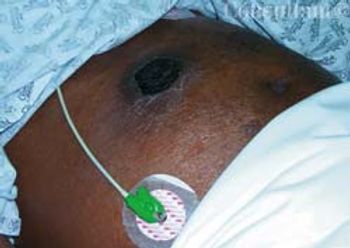
A 78-year-old man with a history of asthma, coronary artery disease, chronic obstructive pulmonary disease (COPD), and recently diagnosed prostate cancer was admitted to the medical ICU with exacerbation of COPD. The obtunded patient was unable to provide a history. A 4 × 6-cm firm nodule of unknown duration was noted over the right upper quadrant of the patient’s abdomen. There were no other cutaneous lesions.

A 38-year-old African American man presented with a 10-year history of a solitary “wart” that had not responded to over-the-counter acid treatments. No other lesions were noted on the patient. Based on the clinical appearance, punctate porokeratosis was diagnosed.
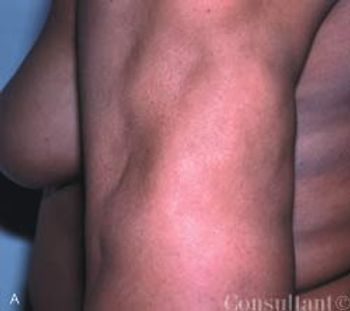
A 1-year history of “dents” on her body prompted a 40-year-old African American woman to seek medical evaluation. Her medical history was unremarkable; however, there was a strong family history of severe type 2 diabetes mellitus. The patient denied having received or having self-administered injections into the affected areas. She reported no history of deep, tender nodules at the sites.

Intense pruritus centered around a sparse “rash” sent a 32-year-old Chinese man for medical evaluation. The patient’s medical and social histories were unremarkable.
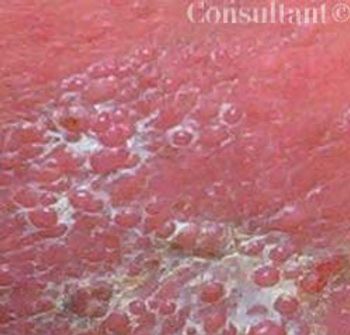
A 62-year-old obese woman with adult-onset type 1 diabetes mellitus had a 6-year history of bilateral leg edema. During the last year, the edema worsened and the skin on her legs thickened. She also had multiple, bilateral, painful, superficial ulcers that drained copiously.

A 12-year-old African American girl comes to youroffice for a well-child checkup. She is tall for herage (height above the 95th percentile) and obese(body mass index [BMI] above the 95th percentile).Physical examination reveals acanthosisnigricans on her neck, axilla, and upper abdominalregion (Figure) and a vaginal yeast infection.Routine urinalysis reveals a glucose level ofgreater than 1000 mg/dL, with negative proteinand ketones. A random blood glucose test, obtainedbecause of the glucosuria, is 249 mg/dL.

A slightly pruritic, red, scaly rash on an 8-year-old boy’shands has been progressively worsening since it appeared4 months earlier. Nail pitting also was noted. There are noother rashes on his body. The patient is active in sports;denies any new exposure to soaps, clothing, or other contactants;and spends time in the homes of his recently divorcedparents.

This condition features acutely tender nodules, marked erythema, and contusions that appear as a consequence of inflammation of subcutaneous fat.
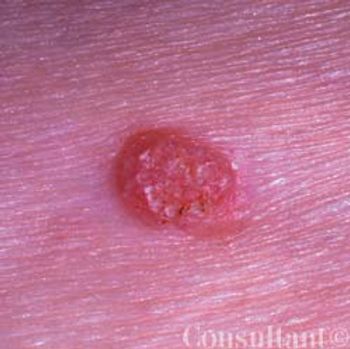
This asymptomatic lesion had been present on a 75-year-old man's right buttock for 2 to 3 years. The 0.5 cm in diameter nodule featured an irregular, flesh-colored surface.

Reiter Syndrome (also called reactive arthritis) manifests as peripheral arthritis that is sometimes accompanied by such extra-articular findings as urethritis, conjunctivitis, and uveitis

Psoriatic Arthritis develops in approximately 20% of patients who have psoriasis.

Pyoderma Gangrenosum belongs in the differential diagnosis of lower extremity vasculitis-like ulcerating lesions.
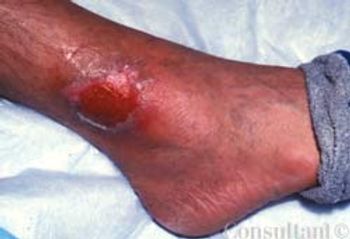
For 3 weeks, an extremely painful lesion had been present on the right ankle of a 46-year-old man. The 7 × 6-cm tender erosion was located just superior to the lateral malleolus. An antibiotic prescribed by another practitioner for a presumed infected insect bite had failed to ameliorate the pain and clear the lesion.

The manifestations of this multisystemdisorder range from relativelybenign, self-limited cutaneous involvementto severe, potentially fatal systemicillness. Skin lesions associatedwith lupus erythematosus (LE) areclassified histologically as LE-specificor LE-nonspecific.

This inflammatory myopathy is believedto be related to immune-mediatedmuscle damage. An increased incidenceof malignancy is associatedwith dermatomyositis (DM), especiallyin patients older than 50 years.
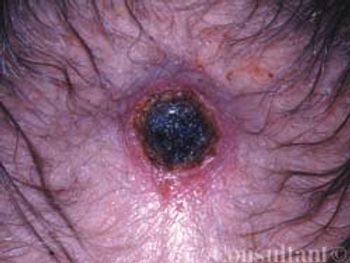
An ulcerated lesion that measured approximately 2 cm in diameter had developed on an 80-year-old woman's scalp. The lesion featured a dark eschar that covered a slightly elevated, erythematous border. According to the patient's husband, a different lesion had been at the site 2 weeks earlier. He described the original as a "ball" that ulcerated, had no drainage, and formed a scab.
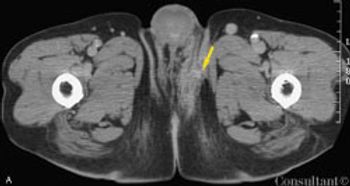
A 77-year-old African American man with type 2 diabetes mellitus and coronary artery disease presented to the emergency department with acute scrotal swelling and pain. His testicles were erythematous with focal areas of necrosis and associated tissue destruction. Similar skin changes were apparent in the lower abdominal and inguinal regions.
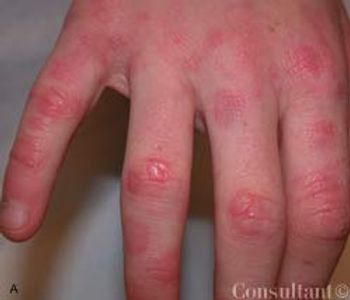
Several asymptomatic, erythematous papules and plaques had appeared on the hands of an otherwise healthy 11- year-old girl. The personal and family medical histories were noncontributory.

A healthy 16-year-old girl was bothered by a patch of white hair on her forehead; she also had a few white plaques on her abdomen, which had been present since birth. Her maternal great grandmother and maternal grandfather, as well as her mother, had a similar pattern of white hair.

A 63-year-old woman presents withdiffuse hyperkeratosis of the solesand palms. She also has onycholysis-separation of the nail plate fromthe nail bed-and salmon-coloredplaques behind her ears. Biopsy ofone of the plaques confirms the suspecteddiagnosis of psoriasis.

A middle-aged man with"jock itch" that has failed torespond to antifungal creams.An older woman who has diffusehyperkeratosis of predominantlyweight-bearing surfaces.A young man with mildlypruritic, small, salmon pinkpapules and thick white scaleon his trunk and arms.

A 30-year-old man presents with scalingand erythema of the scalp that extendspast the anterior hairline. Thepatient has a family history of psoriasis.For the past 5 years, he has experiencedwintertime flares of the diseasethat affect his scalp and the extensorsurfaces of the extremities.

A 46-year-old man complains that his"jock itch" failed to respond to antifungalcreams. The patient has hadpsoriasis on his elbows and knees formany years.

A 72-year-old man presents with skinlesions and nail abnormalities. Erythematous,sharply defined, demarcatedpapules and rounded plaquescovered by silvery micaceous scaleare noted on the elbows, knees, andscalp. Involved areas appear to be bilaterallysymmetric. Localized psoriasisvulgaris is diagnosed.